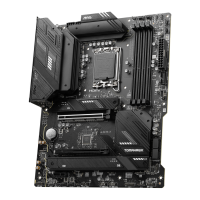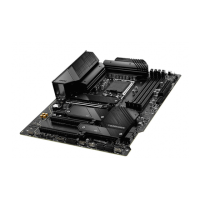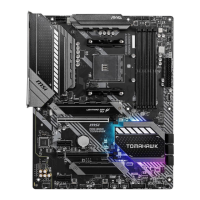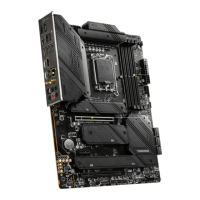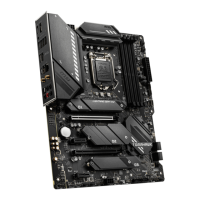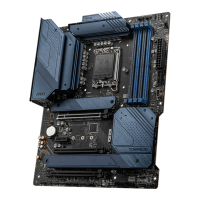
Do you have a question about the MSI MAG B760 TOMAHAWK WIFI DDR4 and is the answer not in the manual?
| Processor socket | LGA 1700 |
|---|---|
| Processor manufacturer | Intel |
| Compatible processor series | Intel Celeron, Intel Pentium Gold |
| Maximum number of SMP processors | 1 |
| ECC | No |
| Non-ECC | Yes |
| Memory channels | Dual-channel |
| Memory slots type | DIMM |
| Number of memory slots | 4 |
| Supported memory types | DDR4-SDRAM |
| Maximum internal memory | 128 GB |
| Supported memory clock speeds | 2133, 2400, 2666, 2933, 3200, 3333, 3400, 3466, 3600, 3733, 3800, 4000, 4400, 4600, 4800, 5000, 5066, 5200, 5333 MHz |
| Supported memory clock speed (max) | 5333 MHz |
| RAID levels | 0, 1, 5, 10 |
| Supported storage drive interfaces | M.2, SATA III |
| Parallel processing technology support | Not supported |
| Number of SATA connectors | 0 |
| USB 3.2 Gen 1 (3.1 Gen 1) connectors | 2 |
| DisplayPort version | 1.4 |
| USB 2.0 ports quantity | USB 2.0 ports have a data transmission speed of 480 Mbps, and are backwards compatible with USB 1.1 ports. You can connect all kinds of peripheral devices to them. |
| Wi-Fi standards | 802.11a, 802.11b, 802.11g, Wi-Fi 4 (802.11n), Wi-Fi 5 (802.11ac), Wi-Fi 6 (802.11ax), Wi-Fi 6E (802.11ax) |
| Bluetooth version | 5.3 |
| Top Wi-Fi standard | Wi-Fi 6E (802.11ax) |
| Ethernet interface type | 2.5 Gigabit Ethernet |
| Audio chip | Realtek ALC897 |
| Component for | PC |
| Product color | Black |
| Motherboard chipset | Intel B760 |
| Audio output channels | 7.1 channels |
| Motherboard form factor | ATX |
| Windows operating systems supported | Windows 10, Windows 11 |
| BIOS type | UEFI AMI |
| ACPI version | 6.4 |
| BIOS memory size | 256 Mbit |
| System Management BIOS (SMBIOS) version | 3.5 |
| Number of M.2 (M) slots | 3 |
| Depth | 304.8 mm |
|---|---|
| Width | 243.84 mm |
Lists essential tools and components for computer assembly.
Details about supported processors, socket type, and compatibility.
Information on the Intel B760 chipset and its features.
Specifications for DDR4 memory slots, capacity, and speeds.
Details on PCIe slots (E1, E2, E3) and their specifications.
Information on HDMI and DisplayPort outputs and resolutions.
Specifies the number and type of SATA 6Gb/s connectors.
Features and functionalities of the MSI Center application.
Design elements for heat dissipation like heatsinks and fan headers.
Key performance-enhancing technologies such as Core Boost and VRM design.
Features designed for ease of installation and user-friendliness.
Details about the audio codec and output capabilities.
Features for controlling RGB lighting and addressable LEDs.
Specific BIOS features like Click BIOS 5.
Identifies the location and function of USB 2.0 ports.
Specifies the DisplayPort output on the back panel.
Details the high-speed USB 3.2 Gen 2 Type-A ports.
Describes the high-speed Ethernet port.
Location of connectors for Wi-Fi antennas.
Identifies the audio output and input jacks.
Specifies the HDMI output port.
Details the fastest USB Type-C port.
Identifies the digital audio output connector.
Illustrates connecting headphones and a microphone to audio jacks.
Shows how to connect stereo speakers using audio jacks.
Identifies the location and type of the CPU socket.
Shows the placement and labeling of memory slots.
Locates and labels the PCIe expansion slots.
Identifies the SATA connectors for storage devices.
Shows the location of M.2 slots for SSDs.
Identifies the front panel audio connector.
Locates front panel connectors for power and reset.
Identifies the chassis intrusion connector.
Shows the locations of main power supply connectors.
Identifies the Thunderbolt add-on card connector.
Locates the connector for the TPM module.
Identifies the front panel USB Type-C connector.
Shows the location of the USB 3.2 Gen 1 front panel connector.
Identifies the front panel USB 2.0 connectors.
Locates the connector for the tuning controller module.
Shows the locations of fan and pump connectors.
Identifies the jumper for resetting the BIOS.
Shows the location of the CMOS battery.
Locates RGB LED connectors for lighting.
Identifies ARGB Gen2 LED connectors for advanced lighting.
Describes CPU notches and the Pin 1 indicator for correct installation.
Illustrates the correct procedure for installing memory modules.
Step-by-step guide for installing an M.2 SSD in the M2_1 slot.
Guide on connecting and configuring the chassis intrusion detection feature.
Steps to reset the chassis intrusion warning message in BIOS.
Illustrates connecting RGB LED strips to the JRGB connectors.
Shows how to connect RGB LED fans using system fan connectors.
Illustrates connecting addressable RGB LED strips to ARGB Gen2 connectors.
Shows connecting ARGB Gen2 LED fans to the system fan connector.
Explains the function of the EZ Debug LEDs for system status.
Step-by-step guide for installing Windows operating systems.
Provides information on accessing the MSI Center user guide for detailed usage.
Lists the benefits and new functions of UEFI BIOS over traditional BIOS.
Discusses potential incompatibilities with older systems or OS.
Steps to verify if the system is using UEFI or Legacy BIOS mode.
Instructions on how to access the BIOS setup utility.
Lists function keys and their corresponding actions within the BIOS setup.
Information on accessing the comprehensive BIOS user guide.
Guide on using the M-FLASH utility for updating the motherboard BIOS.
Details compliance with FCC regulations for radio frequency interference.
Outlines the conditions under which the device complies with FCC rules.
Information on radio functionality and compliance with EMF regulations.
Notes specific restrictions for using radio frequency features.
EU guidelines for battery disposal.
BSMI requirements for battery recycling.
Specific handling information for button cell batteries in California.
Guidance on accessing MSI's website for support resources.
Instructions for registering the product for support and warranty.
